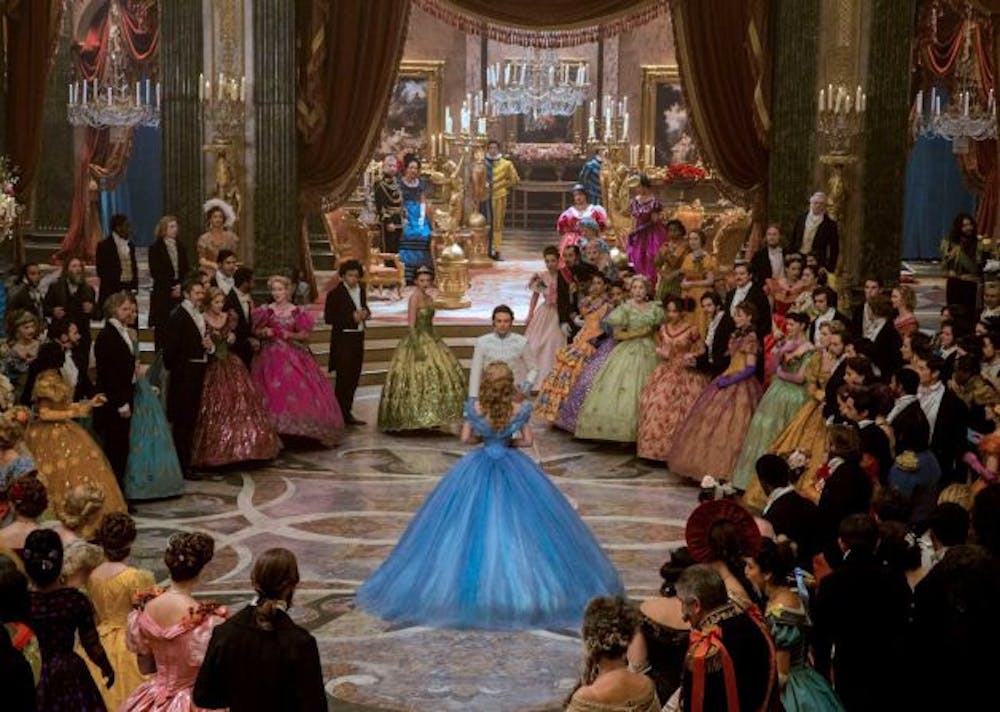By Mackenzie Cutruzzula
Review Editor
The stars of the new “Cinderella” movie are no strangers to breathtaking sights and settings. Lily James (Cinderella) stars in “Downton Abbey” where the vintage set and costumes are praised, while Richard Madden (Prince Charming) is known for his role in “Game of Thrones,” a show that lacks anything but eccentric settings. It is no surprise then that Disney and director Kenneth Branagh continued the recent trend of bold color schemes and elaborate designs in their latest fairy tale come to life.
Set in England, Cinderella’s family home is filled with wild energy and covered wall to wall with different belongings and trinkets from around the world that starkly contrasted the uptight and well-kept palace of the Prince. The film itself was more focused on contrasts than any other element. And of course, no fairy tale is complete without the contrast of the hero and the villain — in this case the innocent Cinderella against her evil stepmother, Lady Tremaine (Cate Blanchett). Both leading ladies were featured in stunning costumes designed by Academy Award winner Sandy Powell. Playing up Lady Tremaine as more fierce than evil, Powell dressed her in late 19th century-inspired fashion that included bright green and cheetah fabrics that exaggerated her matching red hair and lipstick featured in every scene. Whereas the simple Cinderella, known for kindness rather than her beauty, wore rags in her hair to highlight that beauty really does radiate from inside rather than out.
Keeping with costumes, the most important element to Cinderella, of course, is her ball gown and glass slippers. Bringing them to screen was none other than Helena Bonham Carter as The Fairy Godmother, sporting her own frilly white dress. Although missing the song “Bibbidi-Bobbidi-Boo,” the simply dreamlike, blue dress was reimagined from its animated original, with added butterfly details to both the dress and the slippers. The dress encapsulated the magic that made the original idea of Cinderella so timeless.
In fact, most of the movie felt ambiguous in relation to time period and development. This, in turn, gave it a timeless feel that Disney loves to capture, sending a bigger message than just the fluff of costumes and true love. Cinderella’s stepsisters wore big, bright mismatched outfits that reflected their equally big personalities. Despite what was supposed to be considered outer beauty, their mother knew that marrying them off for either love or advantage would be a challenge. Cinderella, on the other hand, had no costume to hide behind. She only had her courage and her kindness to guide her in her challenging life that included an abusive stepmother and a bleak future.

With an entire movie that seemed to be focused on costumes, the focus on Cinderella’s honesty makes her an endearing and relatable character for the audience. She contrasted every other character on the screen, making her identifiable, as Disney reminded the audience that, though everyone feels alone at some point, courage and kindness can help us find our way.
James added an element to the film that I was not expecting from traditional Disney. Although the company has been trying to rebrand the princess image with hits such as “Frozen,” I was pleasantly surprised about how they went about the often thought as weak and damsel in distress character of Cinderella. I, myself, always saw Cinderella as a hard worker and someone I could look up to, though it was more common to see her as a maiden waiting for a man to save her. James didn’t portray a Cinderella looking for a prince to save her. Rather, she played Cinderella as a young girl searching for her own happiness on her own terms. After meeting “Kit,” Prince Charming, in the woods she is not concerned over his status or wealth, but rather how she felt happy around him. This updated Cinderella showed that standing up for yourself is the key to unlocking happiness, and romance is something that can compliment that happiness without being the be all and end all for a girl’s life.
In fact, Cinderella never asked for a savior, she asked for equality. Essentially, Disney wrote what might be considered their first feminist character. This is especially shown through the lack of depth in the character of Prince Charming. Madden was given little to work with in terms of dialogue because the focus wasn’t on his journey — it was on his transition from boyhood to manhood that was ignited by Cinderella. Although it is still a treat to see Madden sporting a sword and royal garb, it was his humility that brought his character to life. Madden and James made magic come to life by demonstrating that being yourself is the best self you can be.
Kenneth Branagh took a 1697 fairytale best known for its outdated, 1950 animated adaptation and completely updated the tale. Staying true to the heart of the film while ditching the original message — “a dream is a wish your heart makes” — Branagh and the cast gave a performance that praised hard work, dedication and staying true to oneself.







